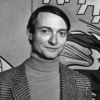Roy Lichtenstein

Roy Lichtenstein
Roy Fox Lichtensteinwas an American pop artist. During the 1960s, along with Andy Warhol, Jasper Johns, and James Rosenquist among others, he became a leading figure in the new art movement. His work defined the basic premise of pop art through parody. Favoring the comic strip as his main inspiration, Lichtenstein produced hard-edged, precise compositions that documented while it parodied often in a tongue-in-cheek manner. His work was heavily influenced by both popular advertising and the comic book style. He...
NationalityAmerican
ProfessionPop Artist
Date of Birth27 October 1923
CityNew York City, NY
CountryUnited States of America